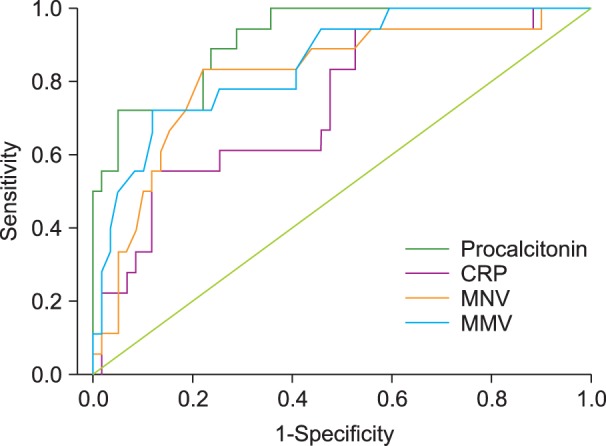Blood Res.
2013 Sep;48(3):193-197. 10.5045/br.2013.48.3.193.
Mean cell volumes of neutrophils and monocytes are promising markers of sepsis in elderly patients
- Affiliations
-
- 1Department of Laboratory Medicine, Catholic University of Daegu, School of Medicine, Daegu, Korea. sgkim@cu.ac.kr
- KMID: 2270705
- DOI: http://doi.org/10.5045/br.2013.48.3.193
Abstract
- BACKGROUND
Sepsis in elderly patients is a major cause of morbidity and mortality in the clinical setting. The aim of this study was to assess the diagnostic significance of volume conductivity scatter (VCS) parameters and to compare their reliability with that of inflammatory markers.
METHODS
Patients (N=85) were divided into 3 groups according to their clinical history and culture results: control (N=29), localized infection (N=38), and sepsis (N=18). VCS parameters were obtained using a UniCel DxH 800 Coulter system. Cut-off values were established based on receiver operator characteristic (ROC) curves.
RESULTS
The mean volumes of neutrophils (MNV) and monocytes (MMV) were higher in the sepsis group than in the localized infection and control groups (P=0.000 for both). The mean cell conductivity and low median angle light scatter of neutrophils were lower in the sepsis group than in the localized infection and control groups (P=0.029 and P=0.022, respectively). With a cut-off of 156.5, MNV had a sensitivity of 83.3% and a specificity of 78% in predicting sepsis.
CONCLUSION
MNV and MMV, which can be obtained easily using an automated blood analyzer, may be promising hematologic parameters for distinguishing elderly individuals with and without sepsis and may help clinicians in the diagnosis of sepsis.
MeSH Terms
Figure
Cited by 1 articles
-
Association between Glycemic Control and Hematologic Indices in Type 2 Diabetic Patients
YeJin Oh, Gye Cheol Kwon, Sun Hoe Koo, Jimyung Kim
Lab Med Online. 2016;6(3):134-139. doi: 10.3343/lmo.2016.6.3.134.
Reference
-
1. Angus DC, Linde-Zwirble WT, Lidicker J, Clermont G, Carcillo J, Pinsky MR. Epidemiology of severe sepsis in the United States: analysis of incidence, outcome, and associated costs of care. Crit Care Med. 2001; 29:1303–1310. PMID: 11445675.
Article2. Gleckman R, Hibert D. Afebrile bacteremia. A phenomenon in geriatric patients. JAMA. 1982; 248:1478–1481. PMID: 7109169.
Article3. Castle SC, Norman DC, Yeh M, Miller D, Yoshikawa TT. Fever response in elderly nursing home residents: are the older truly colder? J Am Geriatr Soc. 1991; 39:853–857. PMID: 1885858.
Article4. Wile MJ, Homer LD, Gaehler S, Phillips S, Millan J. Manual differential cell counts help predict bacterial infection. A multivariate analysis. Am J Clin Pathol. 2001; 115:644–649. PMID: 11345826.5. Isaacman DJ, Burke BL. Utility of the serum C-reactive protein for detection of occult bacterial infection in children. Arch Pediatr Adolesc Med. 2002; 156:905–909. PMID: 12197798.
Article6. Fernandez Lopez A, Luaces Cubells C, Garcia Garcia JJ, Fernandez Pou J. Procalcitonin in pediatric emergency departments for the early diagnosis of invasive bacterial infections in febrile infants: results of a multicenter study and utility of a rapid qualitative test for this marker. Pediatr Infect Dis J. 2003; 22:895–903. PMID: 14551491.7. Kourtis AP, Sullivan DT, Sathian U. Practice guidelines for the management of febrile infants less than 90 days of age at the ambulatory network of a large pediatric health care system in the United States: summary of new evidence. Clin Pediatr (Phila). 2004; 43:11–16. PMID: 14968888.
Article8. Yo CH, Hsieh PS, Lee SH, et al. Comparison of the test characteristics of procalcitonin to C-reactive protein and leukocytosis for the detection of serious bacterial infections in children presenting with fever without source: a systematic review and meta-analysis. Ann Emerg Med. 2012; 60:591–600. PMID: 22921165.
Article9. Procop GW, Hartman JS, Sedor F. Laboratory tests in evaluation of acute febrile illness in pediatric emergency room patients. Am J Clin Pathol. 1997; 107:114–121. PMID: 8980378.
Article10. Krause JR. Automated differentials in the hematology laboratory. Am J Clin Pathol. 1990; 93(4 Suppl 1):S11–S16. PMID: 2180276.11. Richardson-Jones A. An automated hematology instrument for comprehensive WBC, RBC, and platelet analysis. Am Clin Lab. 1990; 9:18–22. PMID: 10149057.12. Jean A, Boutet C, Lenormand B, et al. The new haematology analyzer DxH 800: an evaluation of the analytical performances and leucocyte flags, comparison with the LH 755. Int J Lab Hematol. 2011; 33:138–145. PMID: 20718875.
Article13. Dellinger RP, Carlet JM, Masur H, et al. Surviving Sepsis Campaign guidelines for management of severe sepsis and septic shock. Crit Care Med. 2004; 32:858–873. PMID: 15090974.
Article14. Chaves F, Tierno B, Xu D. Quantitative determination of neutrophil VCS parameters by the Coulter automated hematology analyzer: new and reliable indicators for acute bacterial infection. Am J Clin Pathol. 2005; 124:440–444. PMID: 16191513.
- Full Text Links
- Actions
-
Cited
- CITED
-
- Close
- Share
- Similar articles
-
- Sepsis, Severe Sepsis and Septic Shock in the Elderly
- Novel Markers of Early Neutrophilic and Monocytic Engraftment after Hematopoietic Stem Cell Transplantation
- The Effect of Anesthetic Technique on White Blood Cell Response to Surgery in Patients Who Underwent Laparoscopic Cholecystectomy and Cesarian Section
- The Effect of Perioperative Analgesic Methods on the Postoperative Changes of White Blood Cells in Patients Undergoing Knee Replacement Surgery
- Effect of Propofol on the Apoptosis of Lipopolysaccharide-Treated Mononuclear Cells and Lymphocytes


